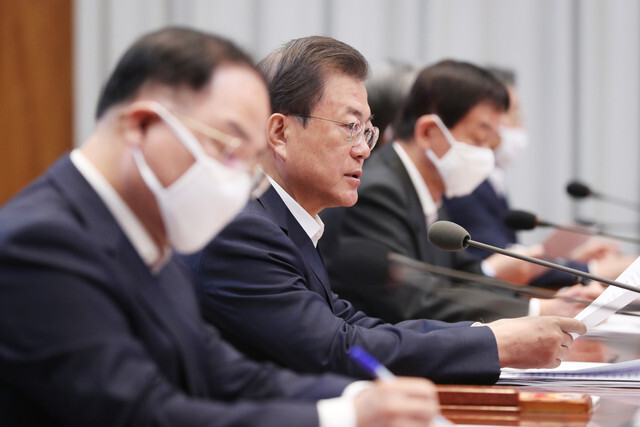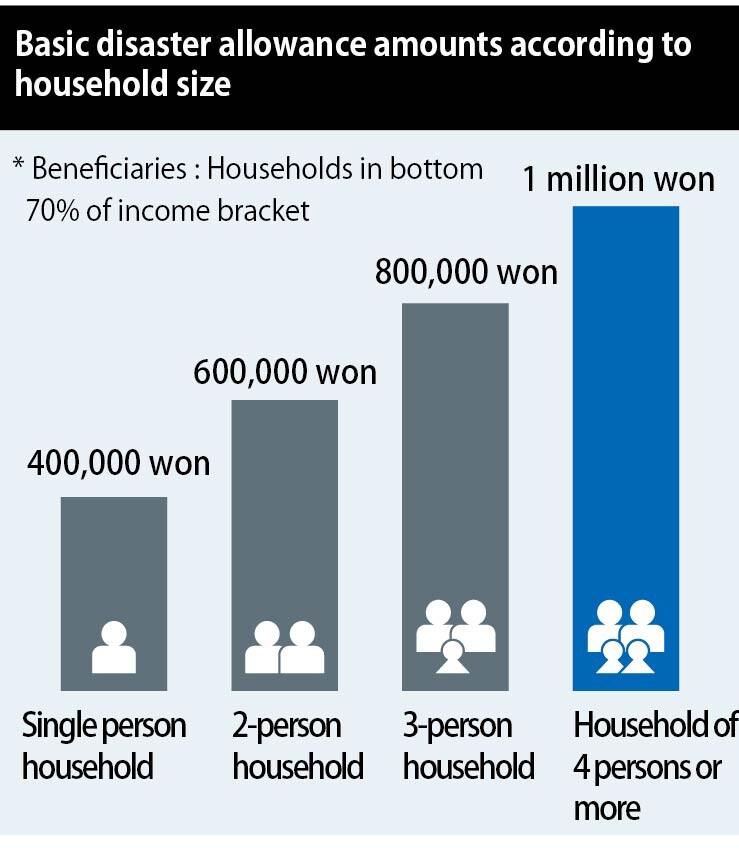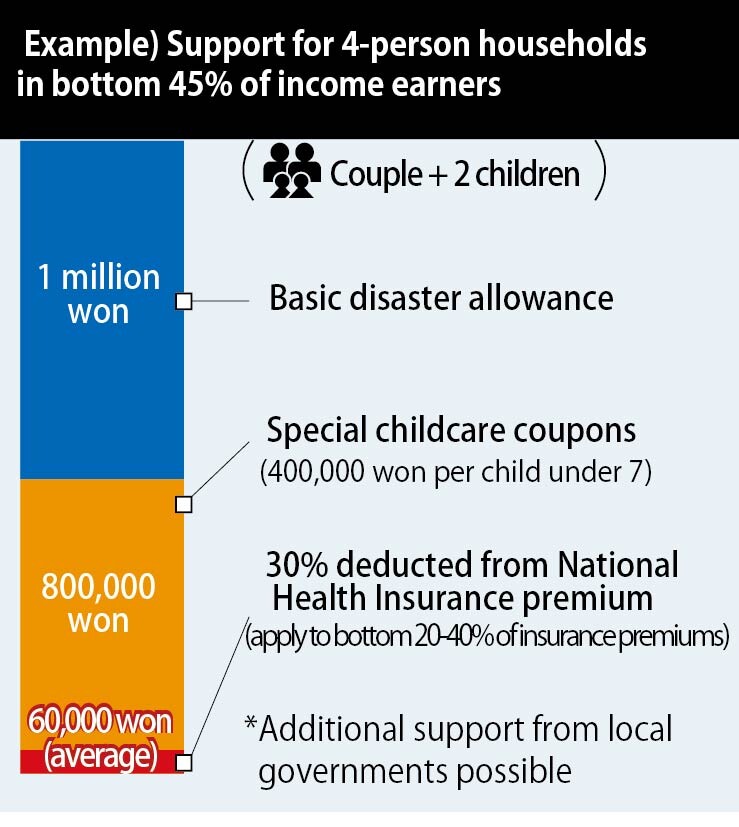hankyoreh
Links to other country sites 다른 나라 사이트 링크
S. Korea to pay basic disaster allowance to bottom 70% of households

On Mar. 30, South Korean President Moon Jae-in announced that the government would be paying up to 1 million won (US$818) in basic disaster allowance to the bottom 70% of households in terms of income, which amounts to 14 million families. The money is aimed at easing the financial difficulties these families are facing amid the COVID-19 pandemic.
In order to raise money for this program, Moon said, the government will draw up a second supplementary budget, to be passed by the National Assembly in April. This is the first time that the South Korean central government has made cash payments to the public during a disaster. Moon’s mention of the need of a second supplementary budget came just two weeks after the National Assembly passed its first supplementary budget, worth 11.7 trillion won (US$9.58 billion), on Mar. 17.

Moon made the announcement during the third meeting of the emergency economic council, which was held at the Blue House on Monday. “The central government has decided to provide basic disaster allowance to families in the lower 70% income bracket, which will include the middle class, in cooperation with local governments. A family of four will receive 1 million won in assistance. Because it’s imperative for these disaster allowances to be administered swiftly, our plan is to quickly submit the second supplementary budget bill [to the National Assembly] and to have the bill passed in April, immediately after the parliamentary elections [on Apr. 15],” Moon said.
The disaster relief will be paid to 14 million of the 21 million households in the country, representing the lower 70% income bracket. The government will be paying 400,000 won (US$328) to single-person households, 600,000 won (US$491) to two-person households, 800,000 won (US$655) to three-person households, and 1 million won (US$818) to households consisting of four or more people. In order to stimulate demand domestic and grease the wheels of the economy, these allowances will be paid in the form of local gift certificates or prepaid cards, rather than cash. The idea is that the prepaid cards and gift certificates are only valid for a certain amount of time, encouraging people to spend rather than hoard.
The disaster relief adds up to a total of 9.1 trillion won (US$7.45 billion). The government plans to raise 7.1 trillion won (US$5.81 billion) of this through its second supplementary budget and to have local governments cover the remaining 2 trillion won (US$1.65 billion).
“If the supplementary budget is passed by the National Assembly shortly after the parliamentary elections in April, we’ll do our best to ensure that the disaster allowances reach the public in May. The cooperation of the National Assembly is critical in this situation,” said Kang Min-seok, spokesperson for the Blue House. In effect, the Blue House is calling on the current members of the National Assembly to put in the necessary work even after the elections are held, given the critical situation in the country.

Moon promised to raise most of the funds for the disaster relief by “through a painful restructuring of the government’s budget, in order to set aside fiscal reserves and reach a quick agreement between the ruling and opposition parties.” As this suggests, the government plans to raise the majority of the 7.1 trillion won (US$5.81 billion) in funding for the supplementary budget by shuffling around funds in the current budget. That will mean making deep cuts in programs where that is possible, particularly in programs that can’t be easily implemented under the new circumstances.
“The financial authorities were very unhappy with the idea of taking on a lot of government debt. We’re also trying to show that the government is taking on its share of the load by doing what it can to halt budgeted programs that are no longer feasible because of COVID-19,” said a senior official at the Blue House.
During the same meeting, Moon explained that he’d struggled with the decision not to extend disaster relief to the entire public and asked for citizens’ understanding. “All South Koreans have suffered because of COVID-19, and you all deserve to be rewarded for the efforts you’ve made and the discomfort you’ve endured in combating the disease. But if the government is to prepare for an economic shock with no clear endpoint and to respond swiftly to unstable employment and a crisis in corporate liquidity, we need to set aside as many financial reserves as possible. I implore those who can hang on a little longer financially to try to understand why these funds need to go to those with a lower income.”

Additionally, the government announced that it would pay 500,000 won (US$409) in livelihood stabilization assistance for up to two months, starting in April, to 100,000 people on unpaid leave and 100,000 freelancers and independent contractors, who were omitted from previous measures to support people’s livelihood amid the COVID-19 pandemic. Even after those two months, individuals who are having trouble supporting themselves can receive up to six months of emergency welfare support, with payments scaled to the size of the household.
By Seong Yeon-cheol, Lee Kyung-mi, and Cho Hye-jeong, staff reporters
Please direct comments or questions to [english@hani.co.kr]

Editorial・opinion
![[Column] Season 2 of special prosecutor probe may be coming to Korea soon [Column] Season 2 of special prosecutor probe may be coming to Korea soon](https://flexible.img.hani.co.kr/flexible/normal/500/300/imgdb/original/2024/0426/3317141030699447.jpg) [Column] Season 2 of special prosecutor probe may be coming to Korea soon
[Column] Season 2 of special prosecutor probe may be coming to Korea soon![[Column] Park Geun-hye déjà vu in Yoon Suk-yeol [Column] Park Geun-hye déjà vu in Yoon Suk-yeol](https://flexible.img.hani.co.kr/flexible/normal/500/300/imgdb/original/2024/0424/651713945113788.jpg) [Column] Park Geun-hye déjà vu in Yoon Suk-yeol
[Column] Park Geun-hye déjà vu in Yoon Suk-yeol- [Editorial] New weight of N. Korea’s nuclear threats makes dialogue all the more urgent
- [Guest essay] The real reason Korea’s new right wants to dub Rhee a founding father
- [Column] ‘Choson’: Is it time we start referring to N. Korea in its own terms?
- [Editorial] Japan’s rewriting of history with Korea has gone too far
- [Column] The president’s questionable capacity for dialogue
- [Column] Are chaebol firms just pizza pies for families to divvy up as they please?
- [Column] Has Korea, too, crossed the Rubicon on China?
- [Correspondent’s column] In Japan’s alliance with US, echoes of its past alliances with UK
Most viewed articles
- 1AI is catching up with humans at a ‘shocking’ rate
- 2After election rout, Yoon’s left with 3 choices for dealing with the opposition
- 3Is Japan about to snatch control of Line messenger from Korea’s Naver?
- 4South Korea officially an aged society just 17 years after becoming aging society
- 51 in 5 unwed Korean women want child-free life, study shows
- 6[Column] ‘Choson’: Is it time we start referring to N. Korea in its own terms?
- 7Korea’s 1.3% growth in Q1 signals ‘textbook’ return to growth, says government
- 8No good, very bad game for Korea puts it out of Olympics for first time since 1988
- 9[Editorial] Japan’s rewriting of history with Korea has gone too far
- 10Why Korea shouldn’t welcome Japan’s newly beefed up defense cooperation with US